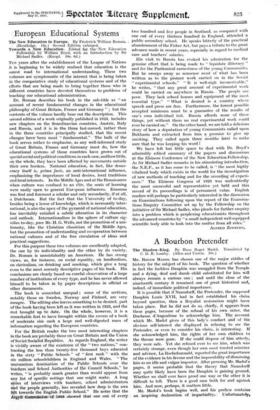A Bourbon Pretender
MR. ROGER MADOL has chosen one of the major riddles of history for the subject of his book. The question of whether in fact the luckless Dauphin was smuggled from the Temple and a dying, deaf and dumb child substituted for him will always remain a curious one ; and until the close of the nineteenth century it remained one of great historical and, indeed, of immediate political importance.
It is possible that if.Nauntiorff, the Pretender, the supposed Dauphin Louis XVII, had in fact established his claim beyond question, then a Royalist restoration might have taken place.. But he did not do so, chiefly, it appears from these pages, because of the refusal of his own sister, the Duchesse d'Angoulerne to acknowledge him. The account which Mr. Madol gives of this lady's conduct and- of the obvious self-interest she displayed in refusing to see the Pretender, or even to consider his claim, is interesting. If she acknowledged him, the rights of her own children to the throne were gone. If she could dispose of him utterly, they were safe. Yet she refused ever to see him, which was certainly strange, even though her own most trusted minister and advisor, La Rochefoucauld, reported the great importance of the evidence in his favour and the impossibility of dismissing him as an idle and vulgar impostor. After perusing Mr. Madol's pages, it seems probable that the theory that Naundorff may quite likely have been the Dauphin is gaining ground. Whether we shall ever have proof one way or the other it is difficult to tell. There is a good case both for and against him. And now, perhaps, it matters little.
Mr. Madol's book begins well, and his preface contains an inspiring declaration of impartiality... _Unfortunately,
however, he more and-more becomes_an advocate of Naundorff's claims and forfeits the reader's sympathy as an impartial investigator. He tells a curious story of one of Naundorff's_ possessions, which reads more like Phillips Oppenheim than history, but of which he vouches for the authenticity. When Jules Favre went out to sign the Peace with Bismarck after 1870 he brought no seal with him to affix to the Treaty. Bismarck suggested that he should use the ring which he saw on his finger and Favre did so. After describing the incident, Favre said :—
" The ring which stood me in such good stead has a curious history: No doubt you know that I was Naundorff's legal aviser and worked for years to clear up the case in favour of that honourable gentleman, who was persecuted so unjustly. In 1852, too, I was his counsel. I would never take a fee from him, but as Naundorff was very anxious to show me his gratitude he gave me this ring, which I have always worn since.' So the armistice was signed with the ring of the sai-disant son of Louis XVI ? " It was."
But the chain of coincidence extended even further.
"The circumstance Which- tdade Natuidorff's ring, an antique gem in a simple gold setting, so famous in the year 1871 had its sequel in our own time. At the end of the Great War Clemenceau sealed the Treaty of Versailles with the same ring which had sealed France's defeat in 1871. After being in Favre's possession the ring hitd after numerous vicissitudes come into Cleinenceau's hands during the war."
As authority for this extraordinary coincidence Mr. Madol gives simply the following note :—
" Clemeneeau's letter to Louis Champion, 24 rue Damremont, Paris (18e)."
Altogether, the book is worth the attention of a historical student, but it is a pity that we have not even yet an impartial and detached investigation of the whole story.















































 Previous page
Previous page